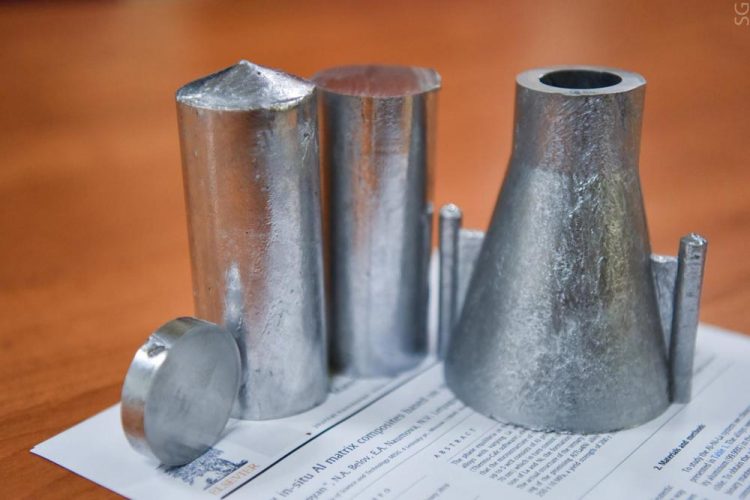Aluminum is the new steel: NUST MISIS scientists made it stronger than ever before

Details made of Al-Ni-La composite material Credit: © Sergey Gnuskov/NUST MISIS
Lighter and faster aircraft and vehicles require lighter materials. One of the most promising materials is aluminum, or rather, aluminum-based composites.
Scientists from NUST MISIS scientific school “Phase Transitions and Development of Non-Ferrous Alloys” created a new strong Al-Ni-La composite for aircraft and automobile industry. Doping elements were added to the aluminum melt, forming special chemical compounds that further formed strong reinforcing structure.
“Our research group, led by Professor Nikolai Belov, has worked on the creation of aluminum-based composites for many years. Al-Ni-La composite is one of such projects, aimed at creation of “natural” aluminum-based composite material with more than 15% vol. of doping elements.
A feature of the new development is the high reinforcing ability of the chemical compounds with ultrafine structure: the diameter of the reinforcing elements does not exceed several tens of nanometers. Previously, researchers were limited to the study of systems in which it is obviously impossible to obtain an effective reinforcing structure.
Or they manufactured composite materials by labor-intensive powder metallurgy methods (sintering of powders), or liquid-phase technologies of kneading nanoparticles in the melt”, Torgom Akopyan, one of the authors, researcher at NUST MISIS Department of Metal Forming, comments.
Today, aluminum is reinforced mainly with the help of nanopowders, but this is an extremely expensive and time-consuming process, where the result does not always justify the means spent. For example, with an increase in strength by only 5-20%, such an indicator as plasticity, on the contrary, can decrease by tens of percent or even several times. In addition, the particles themselves are too large – from 100 nanometers to 1-2 micrometers, and their % vol. is low.
Development of NUST MISIS scientist solves the problem of non-uniform reinforcement and low density of “powder” composites: if melting technique is used, after Al-Ni-La crystallization the diameter of doping particle does not exceed 30-70 nanometers. Thanks to “natural” crystallization, particles are distributed uniformly, forming a reinforcing structure. Hence, the composite becomes more strong and flexible than its “powder” analogues.
“Our composite already demonstrates better characteristics than its analogues, including foreign ones. However, we are not going to stop here, and in the future we plan to continue working on the creation of more advanced, complex (3-, 4 – and more phase) and cheap composites, the production cycle of which will include the use of aluminum of technical purity and cheaper alloying components”, Torgom adds.
According to scientists, the proposed material can be used primarily in aeronautics and automobile industry, as well as for the design of modern robotics, including copters, where reducing the weight of the drone is critical. Due to the peculiarities of the structure formation, the proposed material can be used for the manufacture of complex parts via 3D printing.
In addition, new developments may be of strategic importance from an economic point of view. At the moment, the main share of profit in the aluminum industry in Russia is the export of primary aluminum. The creation of new high-tech developments with increased added value will increase profits by expanding domestic and foreign markets for aluminum consumption.
Media Contact
All latest news from the category: Materials Sciences
Materials management deals with the research, development, manufacturing and processing of raw and industrial materials. Key aspects here are biological and medical issues, which play an increasingly important role in this field.
innovations-report offers in-depth articles related to the development and application of materials and the structure and properties of new materials.
Newest articles

NASA: Mystery of life’s handedness deepens
The mystery of why life uses molecules with specific orientations has deepened with a NASA-funded discovery that RNA — a key molecule thought to have potentially held the instructions for…

What are the effects of historic lithium mining on water quality?
Study reveals low levels of common contaminants but high levels of other elements in waters associated with an abandoned lithium mine. Lithium ore and mining waste from a historic lithium…

Quantum-inspired design boosts efficiency of heat-to-electricity conversion
Rice engineers take unconventional route to improving thermophotovoltaic systems. Researchers at Rice University have found a new way to improve a key element of thermophotovoltaic (TPV) systems, which convert heat…



